4.3 Adolescence
4-
adolescence the transition period from childhood to adulthood, extending from puberty to independence.
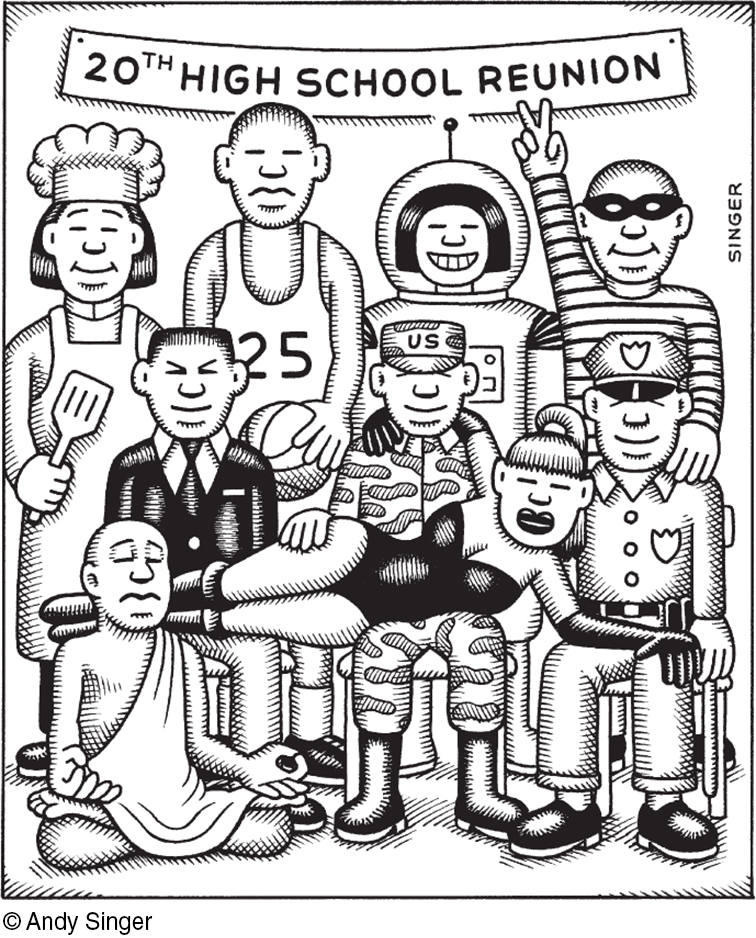
Many psychologists once believed that childhood sets our traits. Today’s developmental psychologists see development as lifelong. As this life-
How will you look back on your life 10 years from now? Are you making choices that someday you will recollect with satisfaction?
G. Stanley Hall (1904), one of the first psychologists to describe adolescence, believed that the tension between biological maturity and social dependence creates a period of “storm and stress.” Indeed, after age 30, many who grow up in independence-
But for many, adolescence is a time of vitality without the cares of adulthood, a time of rewarding friendships, heightened idealism, and a growing sense of life’s exciting possibilities.
Physical Development
puberty the period of sexual maturation, during which a person becomes capable of reproducing.
Adolescence begins with puberty, the time when we mature sexually. Puberty follows a surge of hormones, which may intensify moods and which trigger a series of bodily changes outlined in Chapter 5.
Early versus late maturing. Just as in the earlier life stages, the sequence of physical changes in puberty (for example, breast buds and visible pubic hair before menarche—
148
For boys, early maturation has mixed effects. Boys who are stronger and more athletic during their early teen years tend to be more popular, self-
The teenage brain. An adolescent’s brain is also a work in progress. Until puberty, brain cells increase their connections, like trees growing more roots and branches. Then, during adolescence, comes a selective pruning of unused neurons and connections (Blakemore, 2008). What we don’t use, we lose.
Compared with adults, teens listen more to music and prefer more intense music (Bonneville-
As teens mature, their frontal lobes also continue to develop. The growth of myelin, the fatty tissue that forms around axons and speeds neurotransmission, enables better communication with other brain regions (Kuhn, 2006; Silveri et al., 2006). These developments bring improved judgment, impulse control, and long-
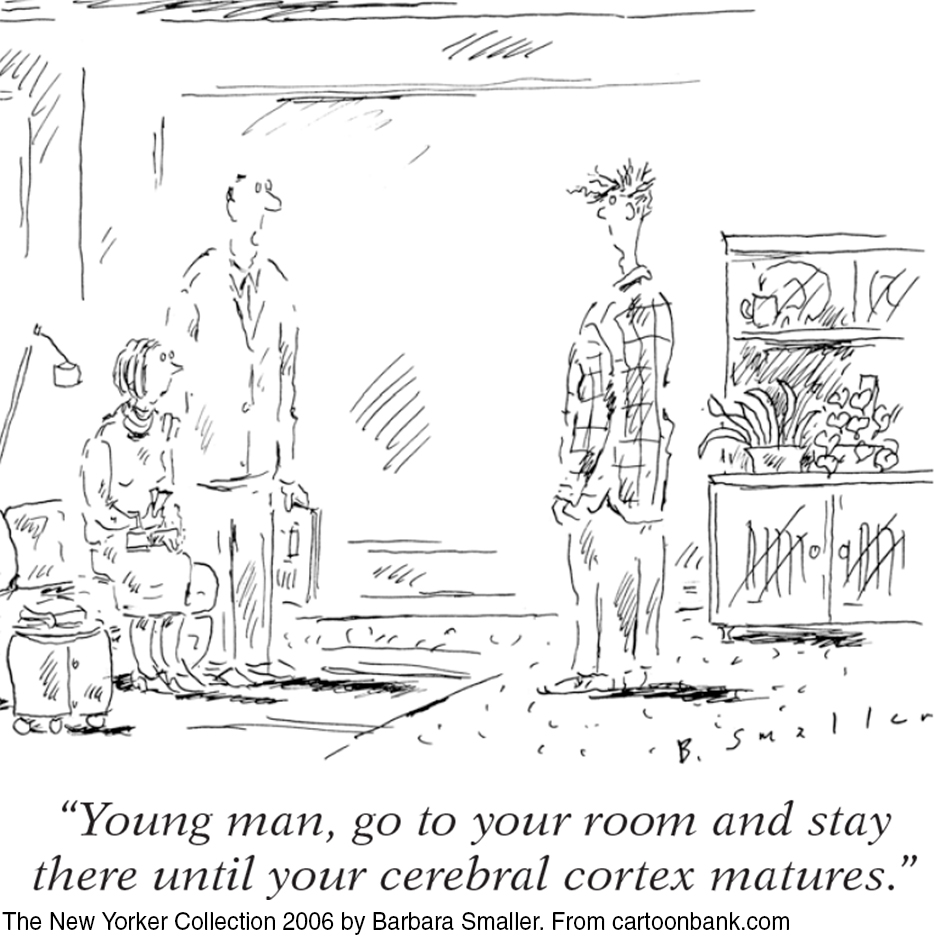
Maturation of the frontal lobes nevertheless lags behind that of the emotional limbic system. Puberty’s hormonal surge and limbic system development help explain teens’ occasional impulsiveness, risky behaviors, and emotional storms—

So, when Junior drives recklessly and struggles academically, should his parents reassure themselves that “he can’t help it; his frontal cortex isn’t yet fully grown”? They can take hope: Brain changes underlie teens’ new self-
In 2004, the American Psychological Association (APA) joined seven other medical and mental health associations in filing U.S. Supreme Court briefs arguing against the death penalty for 16-
149
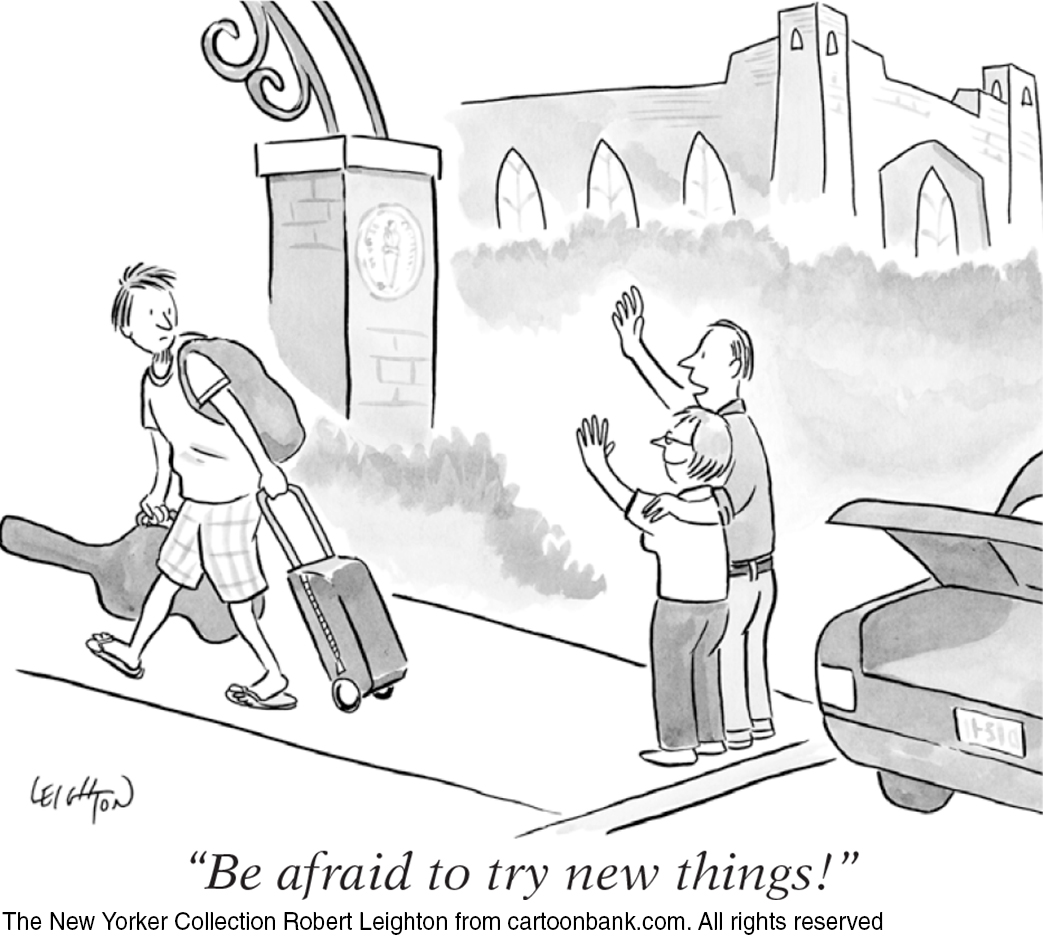
“I helped a so-
M. H., Michigan prison inmate,
personal correspondence, 2015
Cognitive Development
4-
During the early teen years, reasoning is often self-
“When the pilot told us to brace and grab our ankles, the first thing that went through my mind was that we must all look pretty stupid.”
Jeremiah Rawlings, age 12, after a 1989 DC-
Developing Reasoning Power
When adolescents achieve the intellectual summit that Jean Piaget called formal operations, they apply their new abstract reasoning tools to the world around them. They may think about what is ideally possible and compare that with the imperfect reality of their society, their parents, and themselves. They may debate human nature, good and evil, truth and justice. Their sense of what’s fair changes from simple equality to equity—

Developing Morality
150
Two crucial tasks of childhood and adolescence are discerning right from wrong and developing character—
MORAL REASONING Piaget (1932) believed that children’s moral judgments build on their cognitive development. Agreeing with Piaget, Lawrence Kohlberg (1981, 1984) sought to describe the development of moral reasoning, the thinking that occurs as we consider right and wrong. Kohlberg posed moral dilemmas (for example, whether a person should steal medicine to save a loved one’s life) and asked children, adolescents, and adults whether the action was right or wrong. His analysis of their answers led him to propose three basic levels of moral thinking: preconventional, conventional, and postconventional (TABLE 4.3). Kohlberg claimed these levels form a moral ladder. As with all stage theories, the sequence is unvarying. We begin on the bottom rung and later ascend to varying heights, where we may place others’ comfort above our own (Crockett et al., 2014). Preschoolers, typically identifying with their cultural group, conform to and enforce its moral norms (Haun et al., 2014; Schmidt & Tomasello, 2012). When those norms reward kind actions, preschoolers help others (Carragan & Dweck, 2014). Kohlberg’s critics have noted that his postconventional stage is culturally limited, appearing mostly among people who prize individualism (Eckensberger, 1994; Miller & Bersoff, 1995).
Kohlberg’s Levels of Moral Thinking
| Level (approximate age) | Focus | Example |
|---|---|---|
| Preconventional morality (before age 9) | Self- |
“If you save your dying wife, you’ll be a hero.” |
| Conventional morality (early adolescence) | Uphold laws and rules to gain social approval or maintain social order. | “If you steal the drug for her, everyone will think you’re a criminal.” |
| Postconventional morality (adolescence and beyond) | Actions reflect belief in basic rights and self- |
“People have a right to live.” |

MORAL INTUITION Psychologist Jonathan Haidt [HITE] (2003, 2012) believes that much of our morality is rooted in moral intuitions—
One woman recalled driving through her snowy neighborhood with three young men as they passed “an elderly woman with a shovel in her driveway. I did not think much of it, when one of the guys in the back asked the driver to let him off there. . . . When I saw him jump out of the back seat and approach the lady, my mouth dropped in shock as I realized that he was offering to shovel her walk for her.” Witnessing this unexpected goodness triggered elevation: “I felt like jumping out of the car and hugging this guy. I felt like singing and running, or skipping and laughing. I felt like saying nice things about people” (Haidt, 2000).
“Could human morality really be run by the moral emotions,” Haidt wonders, “while moral reasoning struts about pretending to be in control?” Consider the desire to punish. Laboratory games reveal that the desire to punish wrongdoings is mostly driven not by reason (such as an objective calculation that punishment deters crime) but rather by emotional reactions, such as moral outrage (Darley, 2009). After the emotional fact, moral reasoning—
151
This intuitionist perspective on morality finds support in a study of moral paradoxes. Imagine seeing a runaway trolley headed for five people. All will certainly be killed unless you throw a switch that diverts the trolley onto another track, where it will kill one person. Should you throw the switch? Most say Yes. Kill one, save five.
Now imagine the same dilemma, except that your opportunity to save the five requires you to push a large stranger onto the tracks, where he will die as his body stops the trolley. The logic is the same—
While the new research illustrates the many ways moral intuitions trump moral reasoning, other research reaffirms the importance of moral reasoning (Johnson, 2014). The religious and moral reasoning of the Amish, for example, shapes their practices of forgiveness, communal life, and modesty (Narvaez, 2010). Joshua Greene (2010) likens our moral cognition to our phone’s camera. Usually, we rely on the automatic point-

MORAL ACTION Our moral thinking and feeling surely affect our moral talk. But sometimes talk is cheap and emotions are fleeting. Morality involves doing the right thing, and what we do also depends on social influences. As political theorist Hannah Arendt (1963) observed, many Nazi concentration camp guards during World War II were ordinary “moral” people who were corrupted by a powerfully evil situation.
Today’s character education programs tend to focus on the whole moral package—
“It is a delightful harmony when doing and saying go together.”
Michel Eyquem de Montaigne
(1533–
A big part of moral development is the self-
Our capacity to delay gratification—
152
RETRIEVE IT
Question
According to Kohlberg, Pw3Pryc135nBjaJNZC4ppU9S83A= morality focuses on self-interest, EJiqKGnodbVzr/C+FvRa+fuoQ6I+o3AY morality focuses on self-defined ethical principles, and GuYTlFx8SdKMTthGwmYTOBytVMM= morality focuses on upholding laws and social rules.
Social Development
4-
“Somewhere between the ages of 10 and 13 (depending on how hormone-
Jon Stewart et al.,
Earth (The Book), 2010
Theorist Erik Erikson (1963) contended that each stage of life has its own psychosocial task, a crisis that needs resolution. Young children wrestle with issues of trust, then autonomy (independence), then initiative. School-
Erikson’s Stages of Psychosocial Development
| Stage (approximate age) | Issue | Description of Task |
|---|---|---|
| Infancy (to 1 year) | Trust vs. mistrust | If needs are dependably met, infants develop a sense of basic trust. |
| Toddlerhood (1 to 3 years) | Autonomy vs. shame and doubt | Toddlers learn to exercise their will and do things for themselves, or they doubt their abilities. |
| Preschool (3 to 6 years) | Initiative vs. guilt | Preschoolers learn to initiate tasks and carry out plans, or they feel guilty about their efforts to be independent. |
| Elementary school (6 years to puberty) | Competence vs. inferiority | Children learn the pleasure of applying themselves to tasks, or they feel inferior. |
| Adolescence (teen years into 20s) | Identity vs. role confusion | Teenagers work at refining a sense of self by testing roles and then integrating them to form a single identity, or they become confused about who they are. |
| Young adulthood (20s to early 40s) | Intimacy vs. isolation | Young adults struggle to form close relationships and to gain the capacity for intimate love, or they feel socially isolated. |
| Middle adulthood (40s to 60s) | Generativity vs. stagnation | In middle age, people discover a sense of contributing to the world, usually through family and work, or they may feel a lack of purpose. |
| Late adulthood (late 60s and up) | Integrity vs. despair | Reflecting on their lives, older adults may feel a sense of satisfaction or failure. |
Forming an Identity
153
identity our sense of self; according to Erikson, the adolescent’s task is to solidify a sense of self by testing and integrating various roles.
To refine their sense of identity, adolescents in individualist cultures usually try out different “selves” in different situations. They may act out one self at home, another with friends, and still another at school or online. If two situations overlap—
social identity the “we” aspect of our self-
For both adolescents and adults, group identities are often formed by how we differ from those around us. When living in Britain, I [DM] become conscious of my Americanness. When spending time with collaborators in Hong Kong, I [ND] become conscious of my minority White race. When surrounded by women, we are both mindful of our male gender identity. For international students, for those of a minority ethnic group, for gay and transgender people, or for people with a disability, a social identity often forms around their distinctiveness.
Erikson noticed that some adolescents forge their identity early, simply by adopting their parents’ values and expectations. (Traditional, less individualist cultures teach adolescents who they are, rather than encouraging them to decide on their own.) Other adolescents may adopt the identity of a particular peer group—
“Self-
C. S. Lewis,
The Problem of Pain, 1940
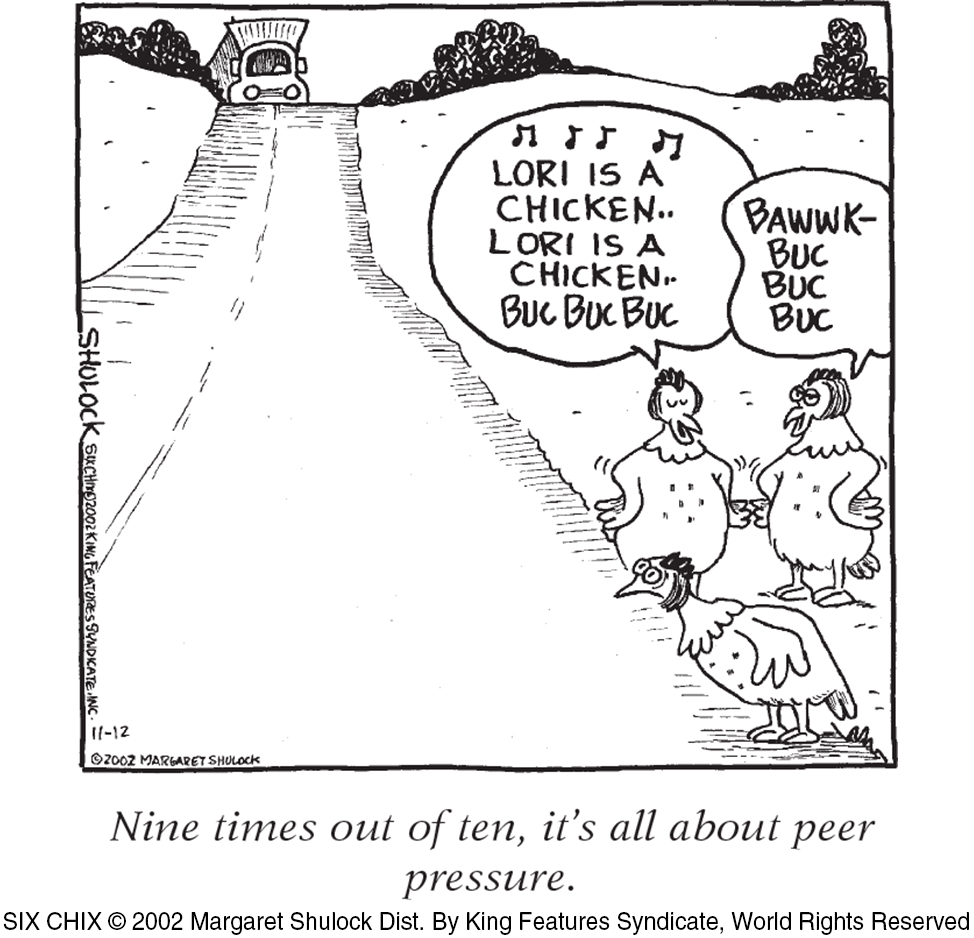
Most young people do develop a sense of contentment with their lives. A question: Which statement best describes you? “I would choose my life the way it is right now” or, “I wish I were somebody else”? When American teens answered, 81 percent picked the first, and 19 percent the second (Lyons, 2004). Reflecting on their existence, 75 percent of American collegians say they “discuss religion/spirituality” with friends, “pray,” and agree that “we are all spiritual beings” and “search for meaning/purpose in life” (Astin et al., 2004; Bryant & Astin, 2008). This would not surprise Stanford psychologist William Damon and his colleagues (2003), who have contended that a key task of adolescence is to achieve a purpose—
Several nationwide studies indicate that young Americans’ self-

These are the years when many people in industrialized countries begin exploring new opportunities by attending college or working full time. Many college seniors have achieved a clearer identity and a more positive self-
intimacy in Erikson’s theory, the ability to form close, loving relationships; a primary developmental task in young adulthood.
Erikson contended that adolescent identity formation (which continues into adulthood) is followed in young adulthood by a developing capacity for intimacy, the ability to form emotionally close relationships. When Mihaly Csikszentmihalyi [chick-
 For an interactive self-
For an interactive self-
Parent and Peer Relationships
154
4-
As adolescents in Western cultures seek to form their own identities, they begin to pull away from their parents (Shanahan et al., 2007). The preschooler who can’t be close enough to her mother, who loves to touch and cling to her, becomes the 14-

As Aristotle long ago recognized, we humans are “the social animal.” At all ages, but especially during childhood and adolescence, we seek to fit in with our groups (Harris, 1998, 2002). Teens who start smoking typically have friends who model smoking, suggest its pleasures, and offer cigarettes (J. S. Rose et al., 1999; R. J. Rose et al., 2003). Part of this peer similarity may result from a selection effect, as kids seek out peers with similar attitudes and interests. Those who smoke (or don’t) may select as friends those who also smoke (or don’t). Put two teens together and their brains become hypersensitive to reward (Albert et al., 2013). This increased activation helps explain why teens take more driving risks when with friends than they do alone (Chein et al., 2011).
“Men resemble the times more than they resemble their fathers.”
Ancient Arab proverb
By adolescence, parent-
For a minority of parents and their adolescents, differences lead to real splits and great stress (Steinberg & Morris, 2001). But most disagreements are at the level of harmless bickering. With sons, the issues often are behavior problems, such as acting out or hygiene; for daughters, the issues commonly involve relationships, such as dating and friendships (Schlomer et al., 2011). Most adolescents—
“I love u guys.”
Emily Keyes’ final text message to her parents before dying in a Colorado school shooting, 2006
Positive parent-

Although heredity does much of the heavy lifting in forming individual temperament and personality differences, parents and peers influence teen’s behaviors and attitudes (See Thinking Critically About: How Much Credit or Blame Do Parents Deserve?)
155
When with peers, teens discount the future and focus more on immediate rewards (O’Brien et al., 2011). Most teens are herd animals, talking, dressing, and acting more like their peers than their parents. What their friends are, they often become, and what “everybody’s doing,” they often do.
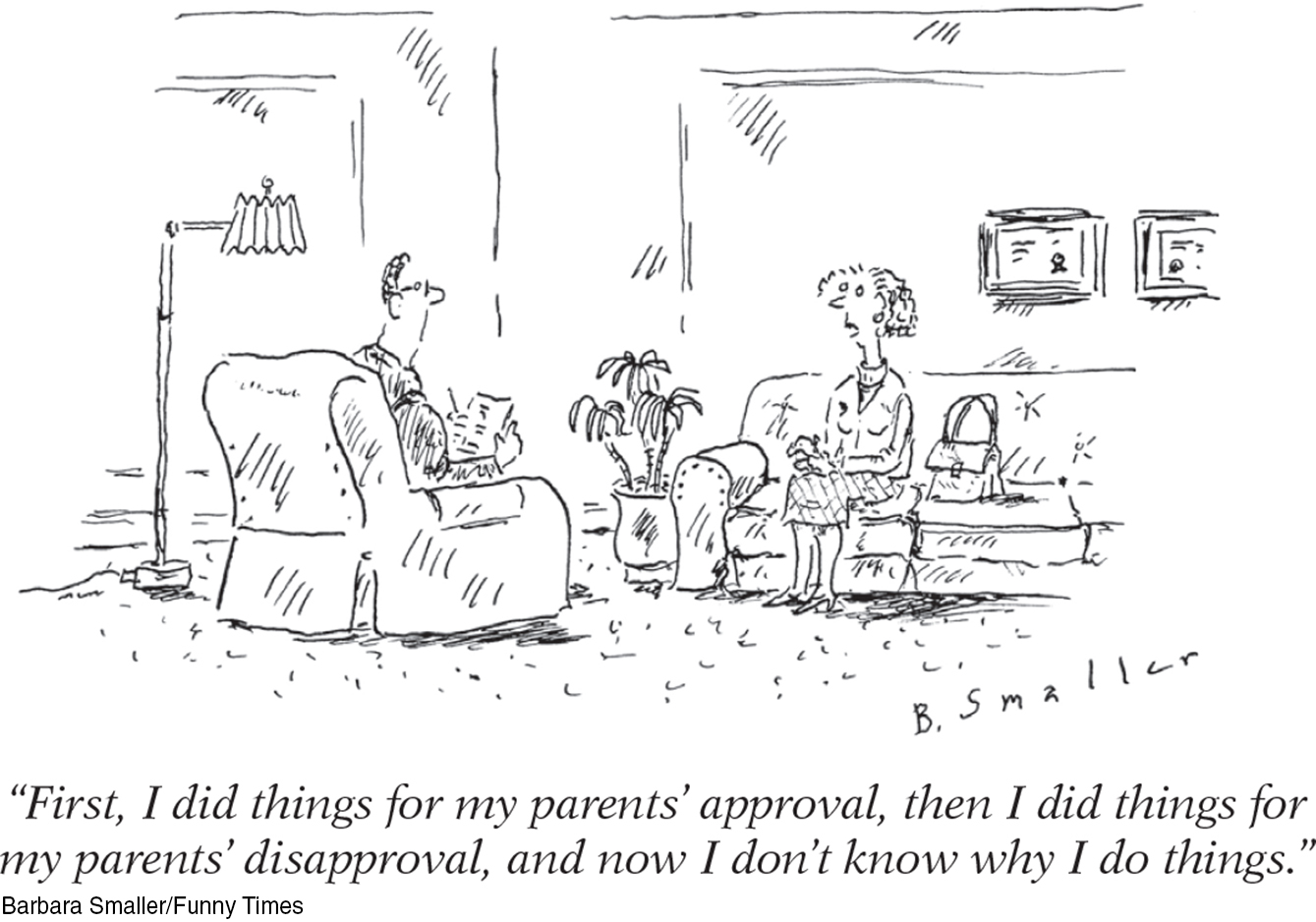
Part of what everybody’s doing is networking—
THINKING CRITICALLY ABOUT
How Much Credit or Blame Do Parents Deserve?
In procreation, a woman and a man shuffle their gene decks and deal a life-
But do parents really produce future adults with an inner wounded child by being (take your pick from the toxic-

Parents do matter. But parenting wields its largest effects at the extremes: the abused children who become abusive, the neglected who become neglectful, the loved but firmly handled who become self-
Yet in personality measures, shared environmental influences from the womb onward typically account for less than 10 percent of children’s differences. In the words of behavior geneticists Robert Plomin and Denise Daniels (1987; Plomin, 2011), “Two children in the same family are [apart from their shared genes] as different from one another as are pairs of children selected randomly from the population.” To developmental psychologist Sandra Scarr (1993), this implied that “parents should be given less credit for kids who turn out great and blamed less for kids who don’t.” Knowing children’s personalities are not easily sculpted by parental nurture, perhaps parents can relax a bit more and love their children for who they are.
For those who feel excluded by their peers, whether online or face-
156
Parent approval may matter in other ways. Teens have seen their parents as influential in shaping their religious faith and in thinking about college and career choices (Emerging Trends, 1997). A Gallup Youth Survey revealed that most shared their parents’ political views (Lyons, 2005).
Howard Gardner (1998) has concluded that parents and peers are complementary:
Parents are more important when it comes to education, discipline, responsibility, orderliness, charitableness, and ways of interacting with authority figures. Peers are more important for learning cooperation, for finding the road to popularity, for inventing styles of interaction among people of the same age. Youngsters may find their peers more interesting, but they will look to their parents when contemplating their own futures. Moreover, parents [often] choose the neighborhoods and schools that supply the peers.
This power to select a child’s neighborhood and schools gives parents an ability to influence the culture that shapes the child’s peer group. And because neighborhood influences matter, parents may want to become involved in intervention programs that aim at a whole school or neighborhood. If the vapors of a toxic climate are seeping into a child’s life, that climate—
RETRIEVE IT
Question
GCAU97BzAenz0tZb27WHaWHkgmU/Nezw+iOzIDotQtl94mCsvuzbiVGAxHOuowDNy0gHFlBEC1/ElKDuv/HjPFangV7YL12fFs2w6IRNlCNwQkC1Yg/vPtDXg+zWxueOAqxU88UioBlyTL0/nrHp4vWXPnjURYR3OY9vl7jnn376GUYwOytSkDUgvE30dZuYOPsZToc3k/2DFTUzYVoZDw==Emerging Adulthood
4-
In the Western world, adolescence now roughly corresponds to the teen years. At earlier times, and in other parts of the world today, this slice of life has been much smaller (Baumeister & Tice, 1986). Shortly after sexual maturity, young people would assume adult responsibilities and status. The event might be celebrated with an elaborate initiation—
When schooling became compulsory in many Western countries, independence was put on hold until after graduation. Adolescents are now taking more time to establish themselves as adults. In the United States, for example, the average age at first marriage has increased more than 5 years since 1960 (to 29 for men, 27 for women). In 1960, three in four women and two in three men had, by age 30, finished school, left home, become financially independent, married, and had a child. Today, fewer than half of 30-
emerging adulthood a period from about age 18 to the mid-
Together, later independence and earlier sexual maturity have widened the once-
157
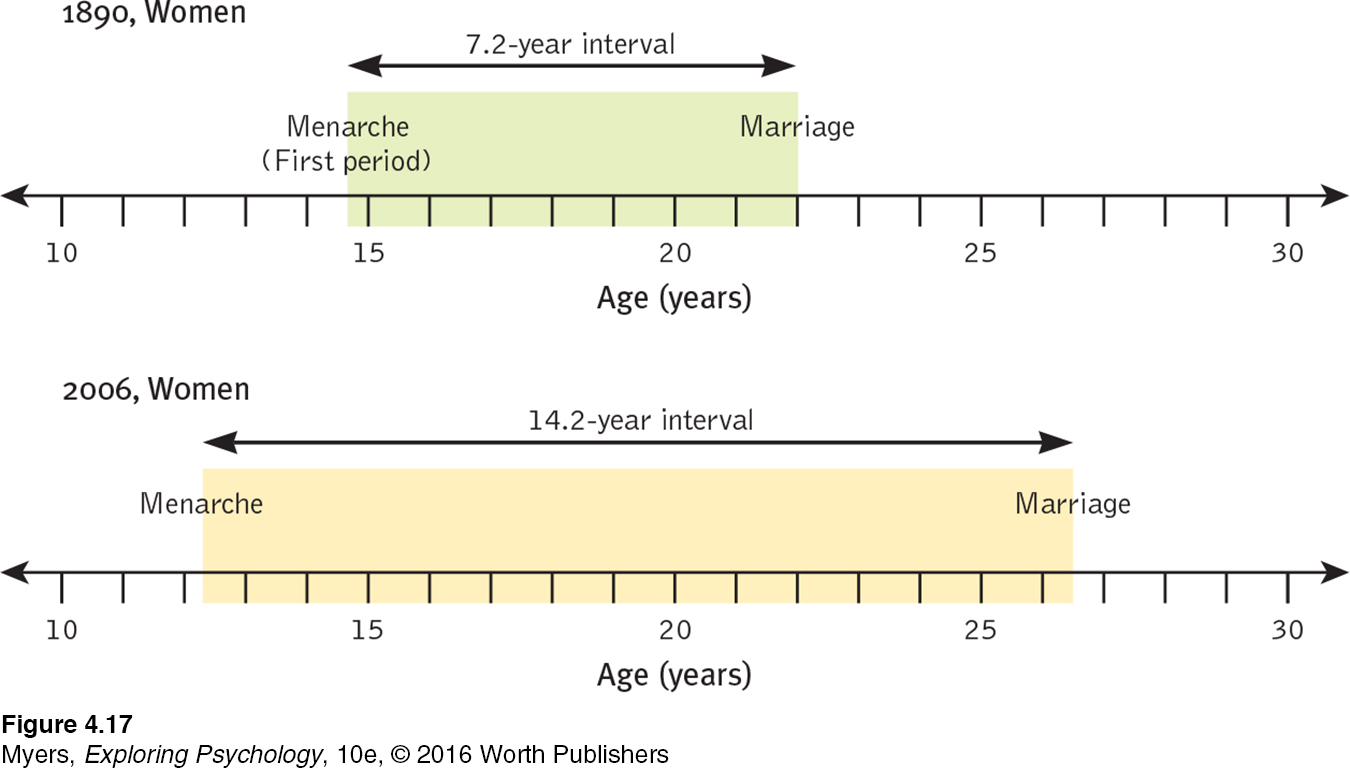
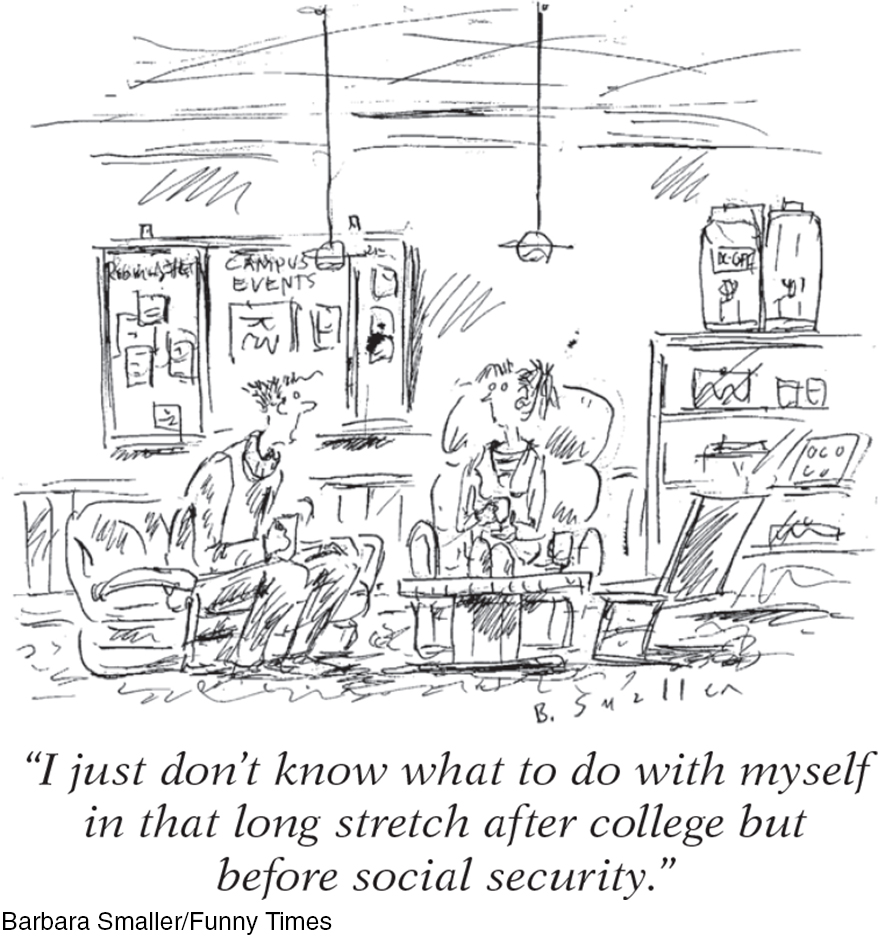
RETRIEVE IT
Match the psychosocial development stage below with the issue that Erikson believed we wrestle with at that stage.
Question
kerJFPhLvHvngvPpXgogRhagjw+28qicakgoPmbtCgSngRBJsbQHtYX6oIExwf8nGb6bUN2FNO35ShB/zbaiN/HygY/92ygLyFCxuNM5t2PywWbVlr0Ce7LEf37qIAFNPhQJ8Y+ZOKhLZrdMQdPZFG0d8ft1m1NJnxQA4gDIfZXuzqQhK03PwNVsPLWOQGk1OkCLCwkBC3ZDOhWPMa27pWCOAlLN251O1JEw+aFUT/Yg/8e0/Qqwo3Mm6Eo4ysQCJ0JEpLhlhEIfr1qWXfJsIVM1UPO84HsS1pDDFlkHkj70Gj2f1Ffo5pOsd+VgGFvRMPplUodLvDrlforGKfy4zzjt6gNkZEbEX0tfYK2yzhdcnKXE2zOZqHIRNtejDeT2SolnKncbKOaFvThgeE4nliKvFDlQ2G9HQMz0nyGqMgzhQe7YPRLRKnQ47gg=REVIEW Adolescence
Learning Objectives
Test Yourself by taking a moment to answer each of these Learning Objective Questions (repeated here from within the chapter). Research suggests that trying to answer these questions on your own will improve your long-
Question
w9Tl11bLSKcqVkRocZzKhaiXQfcrQm9N4Her3zYIPHynlPtMKl1BwYZrUB6uu6UWEyC8NMGw/X5uoegk6kLZfIVutzbu1j2Hkox0ePFSk4oqIzouuxbpGQSqzyxLYCemYi9JKIuzX02lm2Y/WLpsqBky6K61mt7MNB43FVOtVBS6F61zpItbug7ZQLJHibuxx2o0q8Y97PiQGhyXqd/uEDGbgdTzbcKA1NLdhNJ70EyBd4ZEJHBaGh45uPRs5R4NqAwMAg==Question
Sn6KQPA3V+pQYcmsuQQ1tCBEviirVskNG91hxo1Fn1+b0wrwl1Fm2Ntdhre14m5u3jMaDCXZRgBAtB/5dKgPthT7L0ngycDsbB3R9xhPKkuxozGf+s+yBvpYA0oz9pHyUfp2/gyzMC5q3XpTp31OCDAC0Ag5ykvamAApD+oEu5OG4A+l6QLD7PnYq3Tbykzpa3Cp/GEnIJHZTaDKEH8zMcW783jBXz5ZBEAieCOh87AdyOhphzaPv0eWBTU1e0WwKdP5hvs0LupVuGAJNFQYYee5tgut46OrQuestion
FM5xIze6NiqPKZehOHURbqcf0uFG9ATucIK9Kb86dG5IbKx3v/jJqcMpf2XoUpFSwYuJMjWqxKKLmFP4W+2lXrGFxrKdTKfbYYGJK1xqWrUaBGHOlhFk7eCOmTGWsbSjDlFCsFGallHI3Ch0jpRFokMBMFencZlvAarULCjSN4rI1QP731kcfmJccC2IRjyyU9/NK3ZR9Pq3cQWe1cyDKqnELcqWdOA83/jj2w==Question
icQr50Pr36lZIRfwjQRJ/Sv/u+cwicB8lQv5TgaEgaC4gUpWeai1Dev2gfyenV2D6kvIDLXTEUV/8aACREJ41g0Cm6Tm1OuYr9dWbibkCJMI3IaajOkCwBvA76dNaxsoTJIFjuHrPaZdq+v/gJl8nDKIT19MLKW44lCZZVbDl/xYrOldcOVVSCP6LT49JofVeTwRB/Hz+tHXrgtfwmVfp1Kdj8I=Question
7zEU1HfPw3IC1+mTjbf/cW5JHkuxQ97AtdZMSzeh5a5uErz4FwFAPzCyEDn8gZ/wnqVJ9EFy8seTBbsGHjdK1qhzGsdJTT9weCtS0tUGGtnjYt83yQ2n7211UN/wehMUAvNBYM6+WaXKmORfGyWthM63WpyCpzbtMJ7qwxhngJG13VceLLn3ki3GLVVnHIrpTerms and Concepts to Remember
Test yourself on these terms.
Question
9KSXoAa6WsXs9TKZ4ZLHWFO74VJQJJ9qSk6t/eMz2Y62XaRIittkARWFZpswhxQNMgwQkocMZSZZkY5L6Xw1louKlgRiwrYtxqEHczQb+g+syGCdrz0ICDQRbD0JMOtnD7YGJ5r60EnG4zSYoKqrrG20uC6qMqriswtvNtEXGhaZtfkUWTkSxP6uUrxrks7FL2wHQwMF/i8z2eZt8wdtZG/Xn0pUQJx8cOVGWL7ytvV2NhnqRs7C976WGpYcJmMQX/wUnj8J+d20MsbqvYpOxFK7Sbo57MkcsyzMeBCkk3mnmDUe4QT9TMGVqMviOj0oVx53B9FnezJHRNezt0eHMPBXdbC0lW/S5zi3tKKQ3Nr5RuDKBmCxNEX2iGb4XX0TrSqiLtECAf6J1lPPpQlEcU6Qjai4j/WDf7XatVm3qb2p6msI7eP4trAb7g7TF9T3YPR5uTUwQR+hCqH/12sKsRQCBoqAZiFROzykxF+SzL9GFOfEe2L++MACO+AV5yM3/C4KUHkbb5f7fZPk2jSfw4QOhlXCoprK2+OxThwa6I3HXgw1kJVu0xgtGY5vKuFqVz+LFvEfn46mWuBUU5j0QaFEPpD/7m+awUDYpvIPxujDzHnU08WxwoJGIshWxE/7wdXPzNJTEzO3RUKKEz0B7KZwTDG23OFadLyzWA1xY+ia44m9sfpUWhsN3ExO2ULqnZsPOE0dvasHGIYNzOiFw8STn6uaiqvMEZIm5WMHzhEak9HlcusR+cIaYnCFLZmuY5ZH2qrgNbliz5+UfNjyRqg1U3asGyDxJ1rL8hzhA6UU32pOlVWO5T9LPq+iQWy2oDxKga40x94JmoGuvim43WxTvPT0olX/wZN6aijt+9xoOcUczHACGzlbJrdkfqMYrHo2b6JaFs9FjCxo1IUN4VtmRYCM1tZ7m6LhAe0bc6+vswz7s0DG/IDg1NIfM6fUtHug/gntSv4B0k4wHKZr6cdrbdwdjMGAATzSd7rfcCIErc/xSW7JtAngQqF9/T291Li+yn+GGEQAz+5zm2gWh3j5WF/tIE/1u2WUh2OMirDZyiHZa4V7SWeZ5V0w+iyMkczcKaugzwpmbsWmxc+1NZ1Gew9xHJKUNJOtEcOFxCz7uXmL75bxEEeby1mUb57doWcujWCXyb5u4kgWKhF8mw01+8c8KRqPRwEKJBBD8eaOKahPTU4KRHcZghK8cgiuLEkeIPD3M5eGTJf4pj2QqvinvTZCz30W/8vgUM5IypB5/AHueRT/h7GALkIEg9YsUBeBNA==Experience the Testing Effect
Test yourself repeatedly throughout your studies. This will not only help you figure out what you know and don’t know; the testing itself will help you learn and remember the information more effectively thanks to the testing effect.
Question 4.14
Y1iEC5bO0mZgIgY2981LS0gQnAnmBE1o1mll1l3TpnZyaxzo5mkSLSNy8V7goRYm7uxjPVwOHORgWbLNn4O57TkZaYZKOKZzZb+ZPDlrrYBKWjEseoXzTtD4Ykh+AYgbEptUA2zi/E5KiuyhvsEA8BguRG3A7ODM09YtiFhMf3OJsRn8UlPERO51nviCj7gBReOBOkumpG63BYJ84USRLkQ6cjb6rFlM2McBd/Yzy9cXcGLPUJZgms7fqtJle28tSzHEIcIfaWJgl8AsqwV69wNsRwk87ag6O8LFxw==Question 4.15
2. According to Piaget, a person who can think logically about abstractions is in the LuMXQc55RHh5yPNqPT8IMJ7A9OdXhXUA stage.
Question 4.16
l7Zv2oVMkrq0xvQAVxhsyCEQyYRe8XWdhspaNYBeefcycXSf0Rk+fDzlmzwa7u9OUEIrMBVuAhC6kSg5cbIDPtqnC16HA9uNlaOzOqLvQDc2EMtyOzRqpp50Ohh9umDqNZ+uLmgPf8Bh6NPY72apE7Jq1/padPV3qt6GxGAi+cw6vdysnA4yvqEsZpFUNzE6wdlCw6k5WVQEHa3YeZePlyThkKaIlWq+i584zTqyVX9bhcmJusQAAhpWoFFxMkF83dj1W56uKbsei5gkLGOxP1dyvBiqid7K0fFcvWboPQNm7NbzUy+Zj2mALtmYku/Wea8BUTTgK3CnP2FI5tBQig==Question 4.17
4. Some developmental psychologists now refer to the period that occurs in some Western cultures from age 18 to the mid-twenties and beyond (up to the time of full adult independence) as ylaAtGTLVgPhHB7yQ7vHbfoUXa9cxfGH .
Use  to create your personalized study plan, which will direct you to the resources that will help you most in
to create your personalized study plan, which will direct you to the resources that will help you most in  .
.